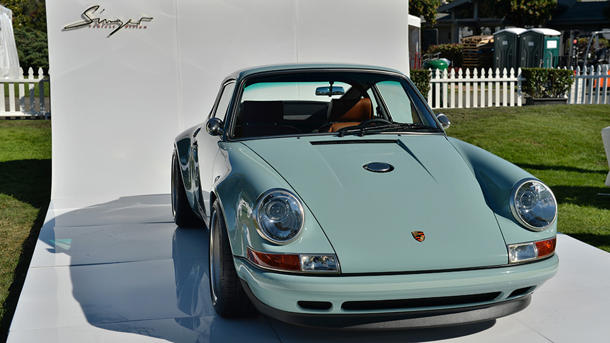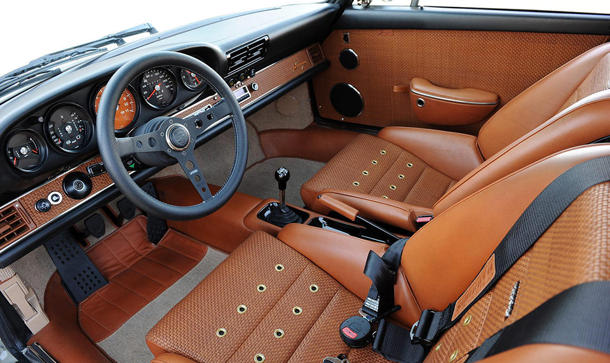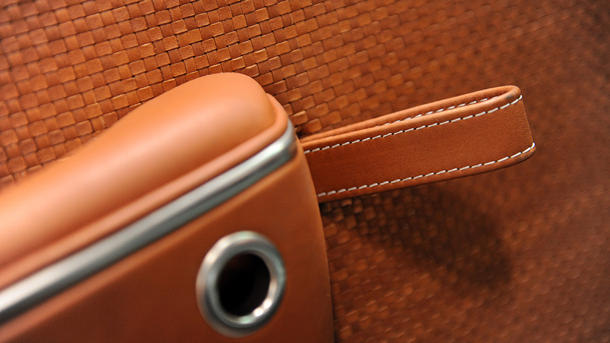Lolling on a manicured lawn during Pebble Beach Concours weekend – the Super Bowl of vintage car shows – a certain blue Porsche looks the museum-worthy part. But in this faintly ridiculous auto country club, whose members include $25 million Ferraris, matchless Bugattis and other gas-powered masterpieces, the Porsche still manages to stand out.
The Porsche 911 is as obsessively restored as any car here. But it’s not period-correct: Not with a feathery carbon-fiber body, Cosworth-designed flat six engine and an 11,000-rpm tachometer that pays sly tribute to Spinal Tap’s favorite number, 11.
This Porsche, built from the air-cooled bones of a 1991 model, has been restored by Los Angeles-based Singer Vehicle Design. And the Renaissance man behind Singer is Rob Dickinson, a lifelong 911 fanatic, university-trained car designer – oh, and the former front man and guitarist of Catherine Wheel, the majestic, serially overlooked British alt rock band of the ‘90s.
The rear-engined fantasy I’m about to drive today, all $480,000 worth, is soon heading to a wealthy collector in Dubai. It’s just the eighth car Dickinson’s company has completed, with three more in various stages of completion and another 11 on order.
Those owners will experience a Porsche quite unlike any other: One part time capsule, one part modern warp speeder, a seven-month labor of love and screw-the-cost craftsmanship. Dickinson’s Porsche philosophy is all about purity: Keeping old parts when they work perfectly, making new (and perfect) ones when they don’t.
“Everything Porsche did was about pure function, so when we attacked the car, that was our mantra,” he says.
That attack starts with a garden-variety Porsche from the company’s internal “964” classification, meaning the chassis sold from 1990 to 1994 in the United States. Dickinson sees that generation, with its trailing-arm suspension and innovative features, as the best and purest of the air-cooled 911s. From there, the hand-built craziness begins: The provocative, flare-hipped body looks much like the rare 911 ST racers built from 1970-71. The carbon fiber skin trims about 400 pounds from the original car, but unlike many modern cars, it’s entirely unexposed: “This isn’t fashion fiber,” Dickinson says.
Inside, the Singer looks like that perfect dessert, so pretty you’re afraid to mess it up. Vintage 911s had a weave pattern embossed into their VW-grade vinyl. This Singer nods to the original but raises the ante with saddle-colored, woven-leather chairs atop carbon-fiber shells. Fragrant hides form the door’s pull straps and panel inserts. A vintage-looking Becker AM/FM radio hides what’s actually a modern audio system, including an iPhone and iPod connector that swings out from a dashboard bulkhead..
A nickel-plated, racing-style spout peeks through the hood opening to access the 25-gallon fuel tank. Under that hood, the cargo area is filled with custom, retro-style fitted luggage and draped with a gorgeous leather blanket.
Yet below the heart-tugging nostalgia lies a Porsche that will tear the hearts out of many modern sports cars.
Owners can choose hand-built, optimized 3.6-liter, 3.8-liter and now a 4.0-liter engine, ranging from roughly 270 to 400 hp. The six is topped with intake manifold of a modern GT3 RS, tastefully lettered with “Porsche” in engraved gold script. Brembo brakes trace a hard-stopping path to the modern 993 Twin Turbo. Öhlins dampers and forged 17-inch wheels, in retro Fuchs style, help pin the car to the pavement.
Now, consider that an early ‘90s Porsche that weighed about 3,100 lbs has been reduced to 2,650. And for hardcore types who want no frills and ultimate performance, Dickinson is prepared to trim the car to as little as 2,200 lbs.
With that kind of power-to-weight ratio, I’m dying to take the wheel. But first we pull off Carmel Valley Road to tighten tiny screws that have set off vibrations in the prototype exhaust system.
“Welcome to the world of custom cars,” Dickinson says dryly.
Everywhere the Singer stops, another car nut emerges from nowhere to flip out over the car – impressive considering the company’s brief track record. Here in this supermarket lot, it’s local Porsche fan Shaun McGeary, who says “This is the one car this weekend I really wanted to see.”
McGeary, in fact, proclaims the Singer to be more compelling than Porsche’s latest supercar, the $845,000 918 Spyder Hybrid.
“The 918 is cool, but I wouldn’t want to own one; how often could you even drive it?” he says. “The 911 is the most iconic sports car ever made, and the Singer is the best iteration yet.”
But don’t take it from him. The finicky lads of the BBC car show Top Gear dubbed Singer’s restoration as “The world’s finest Porsche 911.”
Mechanical hiccups fixed, I jump behind the Singer’s slim-spoked, no-airbag Momo wheel, and ease down the road, getting comfortable with the six-speed gearbox and a surprisingly livable clutch.
I’m not about to beat on a customer’s half-million-dollar car on these pockmarked country roads. But with Rob urging me forward, I begin to realize what kind of metallic magic carpet we’re riding.
This Porsche is all about gas, oil and metal, not silicon and source code. The Singer exudes a sense of actual mechanical parts, spinning, pumping and gnashing to create a beautiful whole.
In old-school fashion, there’s an undeniable learning curve: The Singer bobs and chucks a bit over nasty pavement, even as it sticks, howls and revs like a force of nature. This is no modern Porsche, a car your grandmother could drive fast after 10 minutes at the wheel. Yet I’m jealous of the owner who will experience the joy and fulfillment of long practice sessions to master this machine.
The hydraulic rack-and-pinion steering has some play, but compared to a modern Porsche’s isolated, polite electric rack, it’s also thrillingly connected – if the front wheels squashed a dragonfly, you might feel its dying gasp through your fingertips. Quite remarkably, the Singer doesn’t emit a single squeak or rattle, and rides comfortably enough to be a daily driver.
The Singer is also a dream stealth car. Pull up to a light, and people will say, “Aww, look at the pretty old Porsche.” When the light changes, the Singer will scream “Eat my dust, you insensitive ****,” to borrow the colorful title of one of Dickinson’s early Catherine Wheel tunes.
And from the passenger seat, Dickinson agrees he’s taking the same meticulous approach to cars that he was known for in music.
“I’d say that the same neuroses and obsession that went into music now goes into this car,” he says. “And each car is like a little album: You tinker, you obsess, you finish, and then it’s on to the next one.”
That approach also found its way to Catherine Wheel’s artwork, created by the late Storm Thorgerson, whose famous album covers for the likes of Pink Floyd included the famous triangular prism of light on “The Dark Side of the Moon.”
Dickinson’s own relationship with Pink Floyd, in fact, led the band to cover “Wish You Were Here." And Catherine Wheel’s brilliant 1996 version stands on the mighty shoulders of the original, expanding on it and uncovering new layers.
Come to think of it, Dickinson’s Singer is something of a brilliant cover version. He’s taken a classic that few people would dare tinker with, and through passion and skill, put a personal, emotional stamp on what seemed like a unimprovable design.
Source: Yahoo!





No comments:
Post a Comment